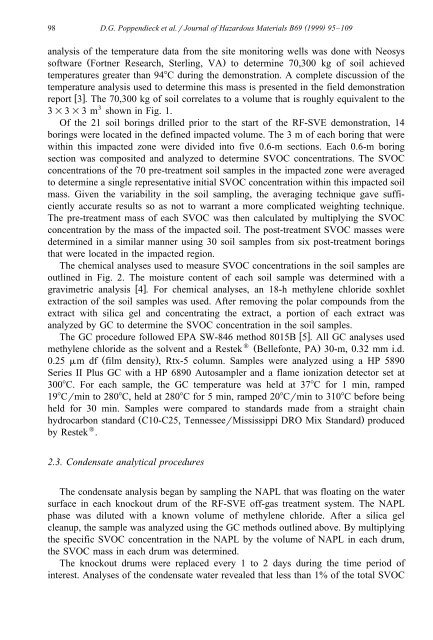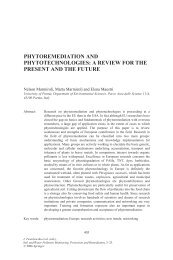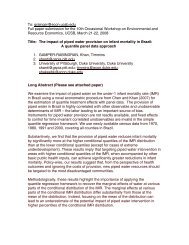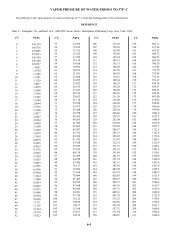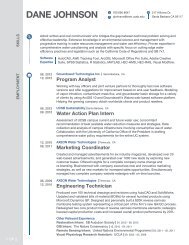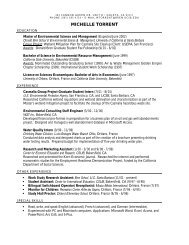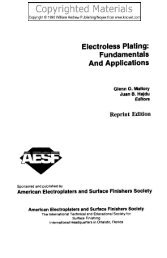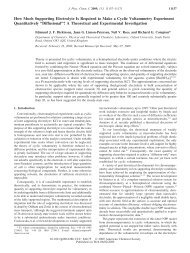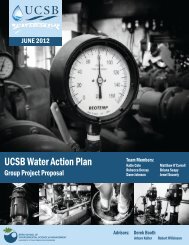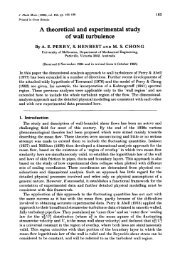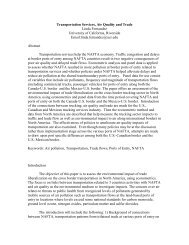SVE Thermal Enhancement
SVE Thermal Enhancement
SVE Thermal Enhancement
- No tags were found...
You also want an ePaper? Increase the reach of your titles
YUMPU automatically turns print PDFs into web optimized ePapers that Google loves.
98( )D.G. Poppendieck et al.rJournal of Hazardous Materials B69 1999 95–109analysis of the temperature data from the site monitoring wells was done with Neosyssoftware Ž Fortner Research, Sterling, VA.to determine 70,300 kg of soil achievedtemperatures greater than 948C during the demonstration. A complete discussion of thetemperature analysis used to determine this mass is presented in the field demonstrationreport wx 3 . The 70,300 kg of soil correlates to a volume that is roughly equivalent to the3=3=3 m 3 shown in Fig. 1.Of the 21 soil borings drilled prior to the start of the RF-<strong>SVE</strong> demonstration, 14borings were located in the defined impacted volume. The 3 m of each boring that werewithin this impacted zone were divided into five 0.6-m sections. Each 0.6-m boringsection was composited and analyzed to determine SVOC concentrations. The SVOCconcentrations of the 70 pre-treatment soil samples in the impacted zone were averagedto determine a single representative initial SVOC concentration within this impacted soilmass. Given the variability in the soil sampling, the averaging technique gave sufficientlyaccurate results so as not to warrant a more complicated weighting technique.The pre-treatment mass of each SVOC was then calculated by multiplying the SVOCconcentration by the mass of the impacted soil. The post-treatment SVOC masses weredetermined in a similar manner using 30 soil samples from six post-treatment boringsthat were located in the impacted region.The chemical analyses used to measure SVOC concentrations in the soil samples areoutlined in Fig. 2. The moisture content of each soil sample was determined with agravimetric analysis wx 4 . For chemical analyses, an 18-h methylene chloride soxhletextraction of the soil samples was used. After removing the polar compounds from theextract with silica gel and concentrating the extract, a portion of each extract wasanalyzed by GC to determine the SVOC concentration in the soil samples.The GC procedure followed EPA SW-846 method 8015B wx 5 . All GC analyses usedmethylene chloride as the solvent and a Restek wŽ Bellefonte, PA.30-m, 0.32 mm i.d.0.25 mm df Ž film density ., Rtx-5 column. Samples were analyzed using a HP 5890Series II Plus GC with a HP 6890 Autosampler and a flame ionization detector set at3008C. For each sample, the GC temperature was held at 378C for 1 min, ramped198Crmin to 2808C, held at 2808C for 5 min, ramped 208Crmin to 3108C before beingheld for 30 min. Samples were compared to standards made from a straight chainhydrocarbon standard Ž C10-C25, TennesseerMississippi DRO Mix Standard.producedby Restek w .2.3. Condensate analytical proceduresThe condensate analysis began by sampling the NAPL that was floating on the watersurface in each knockout drum of the RF-<strong>SVE</strong> off-gas treatment system. The NAPLphase was diluted with a known volume of methylene chloride. After a silica gelcleanup, the sample was analyzed using the GC methods outlined above. By multiplyingthe specific SVOC concentration in the NAPL by the volume of NAPL in each drum,the SVOC mass in each drum was determined.The knockout drums were replaced every 1 to 2 days during the time period ofinterest. Analyses of the condensate water revealed that less than 1% of the total SVOC


